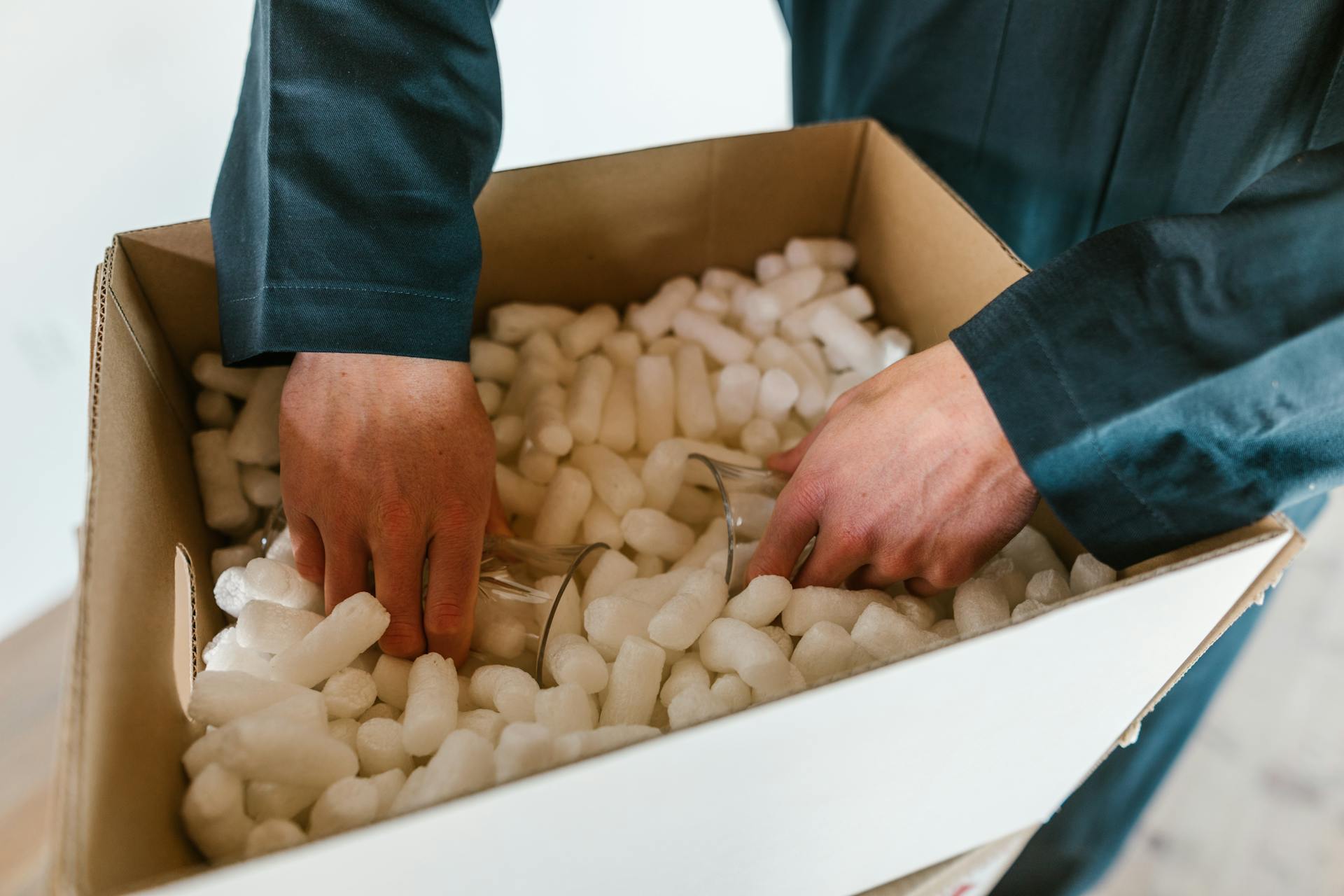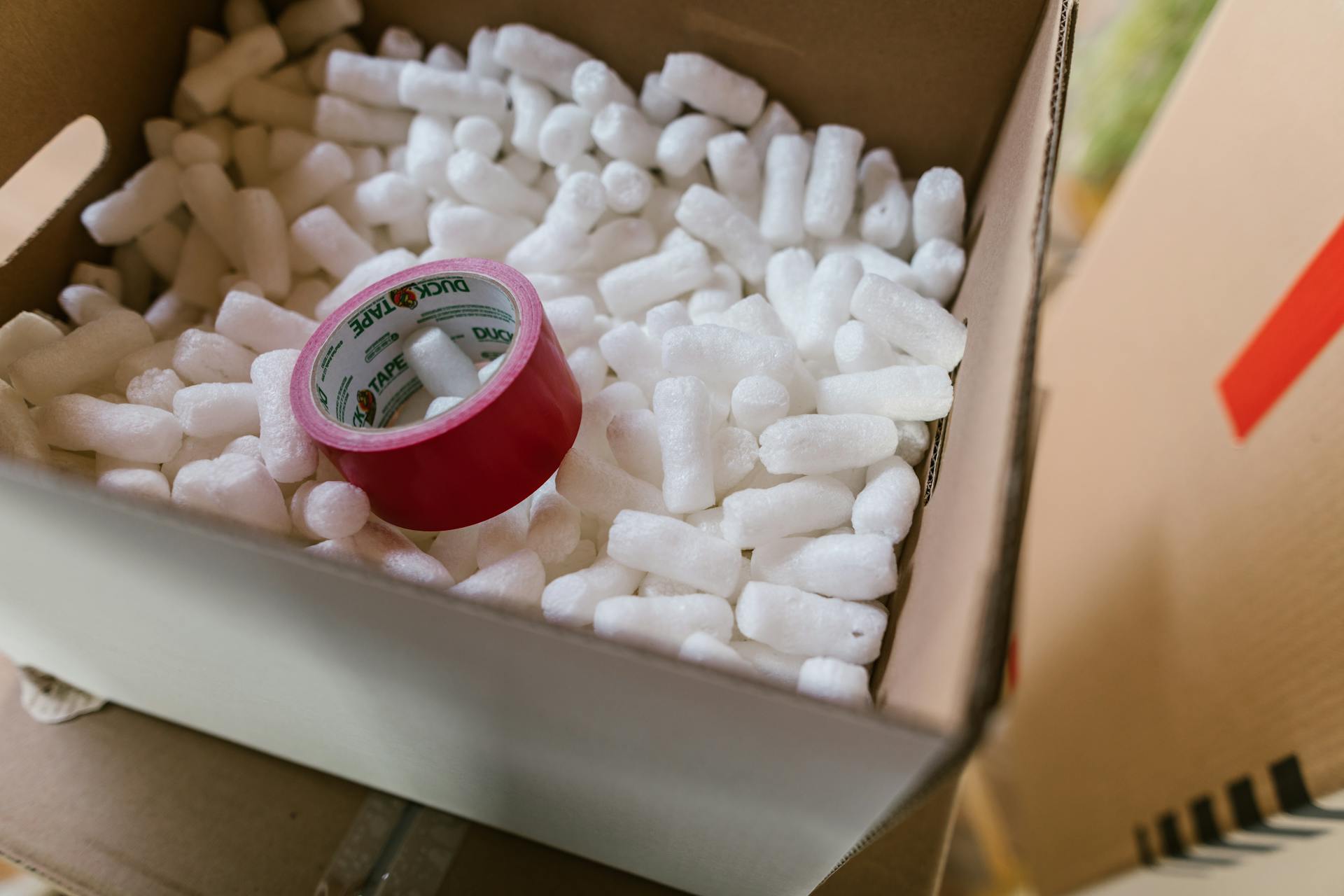
High Impact Polystyrene is a type of plastic that's incredibly versatile. It's a thermoplastic polymer that's made from styrene monomers, which are linked together to form a strong and lightweight material.
High Impact Polystyrene is known for its excellent impact resistance, which means it can withstand a lot of stress and pressure without breaking. This is due to its unique molecular structure, which allows it to absorb and distribute impact forces.
One of the key characteristics of High Impact Polystyrene is its high strength-to-weight ratio, making it an ideal material for packaging and insulation applications. This means it's strong, yet lightweight, and can be easily molded into various shapes and forms.
High Impact Polystyrene is also relatively inexpensive to produce, making it a cost-effective option for manufacturers.
Suggestion: Polystyrene Foam vs Styrofoam
What Is HIPS?
High Impact Polystyrene, or HIPS for short, is a type of plastic that's incredibly durable and versatile.
It's made by combining polystyrene with a small amount of polybutadiene, which adds impact resistance and makes it less prone to cracking.
HIPS is a popular choice for packaging materials, such as egg cartons and foam cups, because it's lightweight and easy to mold into various shapes.
It's also used in the production of plastic containers, such as yogurt cups and margarine tubs, due to its ability to withstand high temperatures.
The addition of polybutadiene also makes HIPS more resistant to abrasion, which means it can withstand scratches and scuffs without showing significant wear.
As a result, HIPS is often used in applications where it will be subject to heavy use or rough handling, such as in the manufacture of plastic cutlery and other disposable items.
Physical Properties
High impact polystyrene (HIPS) is a versatile plastic material that offers a range of physical properties making it suitable for various applications.
HIPS has a tensile strength of 2,480 – 4,520 psi, which is a measure of its ability to resist breaking under tension.
Its flexural modulus is significantly higher, ranging from 193,000 – 381,000 psi, indicating its stiffness and resistance to deformation.

The Izod impact test measures a material's resistance to impact, and HIPS scores 1.2 – 2.8 ft-lbs/in of notch, which is a respectable rating for a plastic material.
Water absorption is an important factor in many applications, and HIPS has a low absorption rate of 0.036 – 0.11% after 24 hours in water at 73°F.
The coefficient of linear thermal expansion (CLTE) for HIPS is 5.0E-5 to 5.1E-5 (in/in/°F), indicating its thermal stability and resistance to expansion or contraction with temperature changes.
Here's a summary of HIPS physical properties:
Manufacturing Methods
High impact polystyrene (HIPS) is typically manufactured through a process called extrusion, where polystyrene beads are melted and formed into the desired shape.
This method allows for a high degree of control over the final product's properties, including its impact resistance and density.
HIPS can also be manufactured through a process called injection molding, which involves injecting molten HIPS into a mold to create the desired shape.
Injection Molding

Injection molding is ideal for small plastic parts and products, especially those needed in large quantities, or parts that need high levels of detail or variable thickness.
The tooling cost is higher with injection molding than thermoforming, but we strive to deliver affordable tooling designs that can be used for additional orders in the future.
High impact polystyrene injection molding works by melting the HIPS into a liquid, then injecting it into the double-sided mold with extremely high pressure.
Once it's cooled and solid, the product is painted, labeled, or coated as needed.
Injection molding is a great option for high unit requirements, resulting in a very low per-unit cost.
Pressure Forming
Pressure forming is a manufacturing method that uses highly pressurized air to blast heated HIPS against a tool.
This process creates a high level of detail, making it ideal for applications where defined edges, corners, and detailing are necessary.
Pressure forming with HIPS can often be used in place of injection molding, and it's commonly used in creating automobile parts, including instrument panels and electronic equipment.
The use of air pressure in pressure forming is three times more forceful than vacuum forming, allowing for precise results.
Pressure forming is a versatile method that can produce complex shapes and designs with ease.
Key Features

High impact polystyrene, or HIPS, is a versatile material with many practical uses.
One of its key features is its low cost, making it an affordable option for various applications.
HIPS is also easy to manufacture, which reduces production time and costs.
It boasts high impact resistance, making it suitable for use in environments where it may be subject to physical stress.
Its high melting point ensures that it can withstand high temperatures without deforming or melting.
You can customize HIPS to fit your specific needs, as it can be molded and shaped into various forms.
HIPS is also easy to recycle, reducing waste and minimizing its environmental impact.
Additionally, it meets food-grade compliance standards, making it safe for use in food packaging and other applications where safety is a top concern.
Here are some key features of HIPS in a nutshell:
- Low cost
- Easy to manufacture
- High impact resistance
- High melting point
- Highly customizable
- Easy to recycle
- Food-grade compliant
Technical Information
High impact polystyrene has a density of 1.06 g/cm³, which is a key factor in its overall weight and durability.

The tensile strength at yield is 22 MPa, which is a measure of how much stress the material can withstand before it begins to deform.
High impact polystyrene also has a tensile E Modulus of 1750 kJ/m², which indicates its resistance to deformation under stress.
Its elongation at break is a relatively low 4%, meaning it can stretch only a small amount before breaking.
High impact polystyrene's Charpy impact notched and unnotched values are 10 kJ/m² and 13 kJ/m², respectively, indicating its resistance to impact damage.
The material's gloss/matt level at 60° is greater than 90 units, making it a shiny and reflective material.
High impact polystyrene has a heat deflection temperature of 87°C and a Vicat softening point of 90°C, indicating its thermal stability.
Flammability testing according to UL94 standards rates it as HB, indicating a moderate level of flame resistance.
Mould shrinkage for high impact polystyrene ranges from 0.4% to 0.7%, which is relatively low and indicates a stable and predictable manufacturing process.
Thermal Conductivity
Thermal conductivity is an important property of materials, and it's measured in Watts per meter per Kelvin (W/m-K).
The thermal conductivity of our material was tested at two different temperatures: 15 °C and 45 °C.
At 15 °C, the thermal conductivity was 0.116 W/m-K.
The standard deviation for the thermal conductivity at 15 °C was very low, at 0.002 W/m-K.
The thermal conductivity increased slightly at 45 °C, reaching 0.128 W/m-K.
The standard deviation at 45 °C was also very low, at 0.002 W/m-K.
Here's a summary of the thermal conductivity results:
Technical Information
Technical Information is a crucial aspect of any material or product. This section provides a comprehensive overview of the technical specifications of a particular material.
The material in question has a density of 1.06 g/cm³, as specified in the ISO 1183 standard. This is a relatively standard density for many materials.
Tensile strength at yield is an important measure of a material's ability to withstand stress. This material has a tensile strength at yield of 22 MPa, as per the ISO 527-2/50 standard.

The material's tensile E Modulus is 1750 kJ/m², according to the ISO 527-2 standard. This value indicates the material's ability to resist deformation under stress.
Elongation at break is another critical measure of a material's properties. This material has an elongation at break of 4%, as specified in the ISO 527-2 standard.
Here are the key mechanical properties of the material:
The material also has a Charpy impact notched value of 10 kJ/m² and a Charpy impact unnotched value of 13 kJ/m², as per the ISO 179/1eA and ISO 179/1eU standards respectively.
The material's gloss/matt level at 60° is greater than 90 units, as specified in the ISO 2813 standard. This indicates a high-gloss finish.
The material's heat deflection temperature is 87°C, according to the ISO 75-2/A standard. This value indicates the material's ability to withstand heat without deforming.
The material's Vicat softening point is 90°C, as per the ISO 306/B50 standard. This value indicates the material's softening point under heat.
The material has a flammability rating of HB, according to the UL94 standard. This indicates a moderate level of flammability.
The material's mould shrinkage is between 0.4% and 0.7%, as specified in the ISO 294-4 standard. This value indicates the material's ability to shrink during the moulding process.
Related reading: High Value Cargo Transportation
Frequently Asked Questions
Is high impact polystyrene reusable?
No, high impact polystyrene (HIPs) is not reusable, but it can be recycled into new products due to its thermoplastic properties.
Sources
- https://www.polymershapes.com/product/high-impact-polystyrene-hips/
- https://materials.fsri.org/materialdetail/high-impact-polystyrene-hips
- https://advancedplastiform.com/materials/hips/
- https://amariplastics.com/hips
- https://www.mulfordplastics.com.au/products/high-impact-polystyrene/
- https://blog.impactplastics.co/blog/learn-about-your-plastic-sheet-7-facts-about-high-impact-polystyrene
Featured Images: pexels.com


